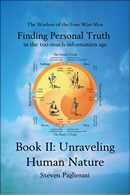The Nature of Autism: What is it?
If you know anyone on the spectrum, you know there is nothing in this person's personality which is not affected by their autism. Whether Kanner's Autism, Asperger's Autism, or PDD-NOS, these folks have personality sized conditions. So why do most of these folks get treated like they're broken and need fixing? The medical model—focus on brokenness—still rules.
According to the medical model then, either you're statistically normal or you're in need of repair. In truth, none of these folks are broken. Rather they each have minority personalities. Admittedly, this idea—that people can have minority personalities—is a controversial one. Equally so is the idea that the autism spectrum should include ADHD and OCD. However, just this month, research was published which, for the first time, physically links the four autisms—Kanner's, OCD, Asperger's, and ADHD. This offers scientific proof for that my original 2004 article on the four autisms is correct.
What's makes this viewpoint so important? Because when people on the spectrum are seen as having minority personalities, this changes the way the world sees them. No longer are they broken. Rather, they are human beings just like the rest of us, each with their own set of talents and troubles.
The Logical Geometry of the Autism Spectrum (the spectrum of distraction mapped) (coming soon)
Autism, OCD, Asperger's and ADD (the Spectrum of Distraction) 2004
Learning to Speak to People with Asperger's (a guide to speaking fussy) 2005
Oh God, My Child Has . . . (does my child have autism?)
Will My Child Ever Be Normal . . . (special interests as a tool to diagnose Asperger's)
Why Does My Child Keep Correcting Me? (Asperger's as "fussy word" disease)
What Is ADHD? (mental vs physical learners)
Why Do Stimulant Medications Help People With ADD? (why do stimulants help?)
The Nature of the Self as a Factor in ADHD and Asperger's (the nature of the self)
How Do I Know If I Have Asperger's? (A Young Woman Asks)
Diagnosing Asperger's (Changing our Focus from Symptoms to People)
What's it Like to Have Asperger's? (a Young Mother Asks)
the Social Paradox of Asperger's: (from Social Deficit to Society's Asset)
Please Help! My Daughter is Autistic (On Kanner's, Asperger's, and PTSD)
Can We Cure ADD? (Clues from the Mind Body Connection)
To Angela: On Attention Deficits and Hyperactivity (Visually Defining the Nature of the Injury)
To Lisa: ADD, Medical Labels, and Emergence (Encouragements to Be Personally Involved in One's Healing)
Social Priorities and Managing One's Health (Talking to Annie About Coming Out of Shock)
To me, one the more inane decisions medicine has made is changing the diagnosis they call ADD to ADHD. Here the AD part is still Attention Deficit Disorder. But the HD part is Hyperactivity Disorder. Do all kids with ADD have HD? Not really. And they acknowledge this in the new diagnosis. It reads ADHD with or without HD. The really stupid part though is not this ridiculous label. It's that they do not recognize the possibility that hyperactive kids might not have ADD.
Labeled Hyperactive: (Introduction)
Alice and the Cat Food (helping a little girl who couldn't sit still)
Alex and the Dentist (helping a little boy who couldn't sit still)
Closing Thoughts on Hyperactive Children (focusing on their aloneness)
In 2006, when I wrote these articles, I had not yet begun to call these four conditions, " minority personalities." In effect, by doing this, the four poles on the Autism Spectrum are seen not as illnesses or brokenness but rather, as empirically testable personalities. To wit, in these articles I describe the four fractal patterns with which all people make their decisions. With folks on the spectrum, however, these patterns are so visible as to be useful in diagnosing these conditions.
the Four Styles of Decision Making (introduction)
Style 1: the Asperger's Decision Tree (precision, correction, digression, bluntness)
Style 2: the ADD Decision Tree (digression, bluntness, precision, correction)
Style 3: the Autism Decision Tree (bluntness, precision, correction, digression)
Style 4: the OCD Decision Tree (correction, digression, bluntness, precision)
The Asperger's and ADD Decision Trees Contrasted and Compared (step by step)
The Autism and OCD Decision Trees Contrasted and Compared (step by step)




.png)